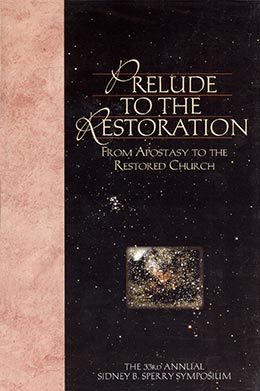Preface
Fred E. Woods, Steven C. Harper, Andrew H. Hedges, Patty A. Smith, and Thomas R. Valletta, Preface to Prelude to the Restoration: From Apostasy to the Restored Church (Provo, UT and Salt Lake City: Religious Studies Center, Brigham Young University and Deseret Book, 2004).
In years past the Sperry Symposium has provided speakers and hearers, authors and readers a valued opportunity to engage one of the standard works of Latter’day Saint scripture. That esteemed tradition has been expanded recently to include reflections on the Church in the twentieth century. This volume looks forward to the two hundredth anniversary of the birth of Joseph Smith in 2005 by looking back to some of the events, processes, people, and ideas that set the stage for the marvelous Restoration begun by the Prophet.
Latter-day Saints acknowledge the hand of the Almighty in shaping history. Unsurprisingly, then, as the distinguished historian Gordon S. Wood wrote, the Restoration “appeared at precisely the right moment in American history” (“Evangelical America and Early Mormonism,” New York History, October 1980, 381). One might add that, in anticipation of the Restoration, America appeared at precisely the right moment in world history. Indeed, because of the Restoration we know that the earth itself appeared in its proper time and season. This volume provides glimpses into the complicated choreography of history by which the world became ready for Joseph Smith and the restoration of the Church of Jesus Christ. The complex processes at work between the Apostasy and the Restoration do not lend themselves to reduction or simplification, and this volume cannot impose unwarranted order on the chaos. Yet it identifies themes, movements, and people who participated in making the moment right for the Restoration, including some that are ignored or unknown by many Latter-day Saints. These deserve attention.
The theme of this year’s Sperry Symposium was influenced by a devotional address Elder M. Russell Ballard delivered to the student body at Brigham Young University-Hawaii (“What Price Religious Freedom,” November 2, 2001): “ I had prepared a talk, written it, and had it prepared to give to you by the teleprompter,” he said, but “in the middle of the night I had the impression that I was to set that aside and speak to you from my heart, as a father would speak to his children, on a matter that the Lord apparently wants someone here to hear and to understand.” He then quoted the first nine verses of Mark 12, the parable of the wicked husbandman, “a scripture,” he said, “that many of you have undoubtedly read but perhaps you have not understood.” Elder Ballard said he believed “the Savior, in this parable, is teaching us how many times our Heavenly Father has tried to send His prophets among His people to establish His gospel and to bless the lives of His children.”
Highlighting the history of servants (prophets) being sent into the vineyard, Elder Ballard suggested that many of the early Christian leaders and the medieval and early modern reformers of Christendom are among those the Lord has sent forth. “ I want to talk to you about something we must never, ever, forget,” Elder Ballard emphasized. “As we walk through this process of mortality as members of the Church, we must appreciate that there has been a terrible price paid for the privilege you and I have to be members of The Church of Jesus Christ of Latter-day Saints. I pray with all the power that I have, as an apostle of the Lord Jesus Christ, that there would not be one of you students that would ever take this privilege casually or lightly. I would pray that you would focus some of your study on what price has been paid, by those who have gone before us, to give us the privilege of walking in the light and knowledge of the gospel.” He mentioned John Wycliffe and Jan Huss, William Tyndale, Martin Luther, Anne Askew, Hugh Latimer, and Nicholas Ridley. For most of us these are names little known if at all. And that was Elder Ballard’s point. “You need to know,” he said again and again, adding such imperatives as “you need to study,” “we must never lose sight,” and “we must never forget.”
Elder Ballard’s talk and the Spirit that inspired it have impressed many, including contributors to this volume, to study the men and women who labored largely in the dark in anticipation of the glorious Restoration. They helped make a world in which the Prophet Joseph Smith could function. If they did not see quite clearly, they may be excused, for they gave their all. What follows is offered in the spirit of contributing a small part toward realization of Elder Ballard’s emphatic hope that we will become better acquainted with what “had to happen in order for the Lord in 1820 to take a boy in Palmyra into a grove of trees where he communicated with God the Father and his Beloved Son, the Lord Jesus Christ.”
The 2004 Sidney B. Sperry Symposium Committee
Fred E. Woods
Steven C. Harper
Andrew H. Hedges
Patty A. Smith
Thomas R. Valletta
